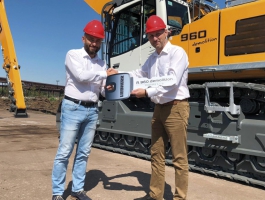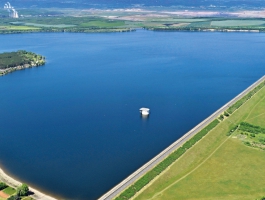 Aktuality
Aktuality  Zajímavosti
Zajímavosti  Safety assessment of a steel frame using the LRFD and SBRA methods
Safety assessment of a steel frame using the LRFD and SBRA methodsSafety assessment of a steel frame using the LRFD and SBRA methods
Rubrika: Zajímavosti
The computer revolution allows for considering a transition from current prescriptive reliability assessment methods, such as Load and Resistance Factor Design (LRFD) to fully probabilistic concepts, such as Simulation- Based Reliability Assessment (SBRA). The subject of the paper is a comparison and discussion of differences between above mentioned methods using safety assessment of a planar steel frame as an example.
I. Introduction
Advances in computer technology allow for considering transition from structural reliability assessment concepts developed in the pre-computer era to fully probabilistic concepts equivalent to the increasing potential of modern computer technology. Such transition requires reengineering of the entire reliability assessment procedure starting from the new representation of loading to the reliability expressed by comparing the obtained probability of failure Pf and target probability Pd specified in the Codes.
The deterministic approach to the structural reliability assessment (such as the Allowable Stress Design) has been gradually replaced in the last four decades by a semi-probabilistic (or “prescriptive”) approach, the Partial Factors Design (see, e.g., the Load and Resistance Factor Design in the U.S., and Eurocodes in Europe). The reliability of structures is now considered to be a function of random variables. The concept of a limit state surface separating a multidimensional domain of random variables into “safe” and “unsafe” domains has been generally accepted and is increasingly used in structural reliability theory, design applications and in the Codes.
Current specifications for structural design, such as AISC, Eurocodes, and ISO, are based on the Partial Factors concept using the “Design Point” approach, reliability index b, and load and resistance factors as the main tools in evaluating reliability. When considering multi-random-variable input resulting from statistical and probabilistic evaluation of data, consistent assessment of reliability based on this concept can become extremely difficult or even impossible. Designers may find the corresponding procedures to be too complicated, difficult to understand and inefficient from their perspective. The reliability check is not explicitly defined or fully explained in the specifications. It may be concluded that the target reliability is set to predefined values and the complete reliability assessment scheme is somewhat hidden in a “black box”. The designer’s creative work is limited to interpretation of regulations and instructions contained in the codes to meet the predefined reliability.
With modern computer technology, the methods based on sampling and simulations are very efficient. The simulation technique is a convenient and very powerful tool for the analysis of loads, load effect combinations, resistance, safety, durability and serviceability in the case of single- as well as multi-component variables. Taking into account the potential of available personal computers, a pilot reliability assessment scheme has been developer based on the representation of individual variables by bounded histograms and calculating the probability of failure Pf, (see Simulation-Based Reliability Assessment method (SBRA), documented in Ref. 3). In order to make the introduction of the simulation procedure easily accessible to the designer, a direct version of the Monte Carlo technique can be applied.
The subject of the paper is a comparison and discussion of the structural safety assessment procedures/kriteria according to the LRFD AISC Code and according to the probabilistic SBRA method. The selected assignment is common and identical for both approaches discussed, however, substantial differences must be considered in each step of the assessment procedure. Each component of the design criteria and each major step of the design procedure are discussed and compared in a special side by side format. Some of the sections are supplemented with appendices to more closely specify the given problems.
II. Assignment
A planar steel frame shown in Figure 1 is exposed to several vertical and horizontal uncorrelated variable concentrated or uniformly distributed loads (short lasting, long-lasting and dead load). The maximum values of each load are indicated in Table 1. It is assumed that the displacements of all components out of the frame plane are prevented. The effect of residual stresses is implicitly considered in LFRD column curves. The SBRA method shows the effects of residual stresses included in the equivalent geometrical imperfections. In the following Sections 3 to 8 the main components of the safety assessment procedure are specified according to the LRFD and SBRA methods. The left and right columns and the beams are hot rolled profiles IPE 220; the middle column is hot rolled profile IPE 240 (for details see Table 2).
| Table 1. Loading data | ||
| Loading | Maximum (Design) Value | |
| Symbol | Description | |
| V1 | Dead load (G1d) | 200 kN (44,96 k) |
| Short lasting load (S1d) | 150 kN (33,72 k) | |
| Long lasting load (L1d) | 50 kN (11,24 k) | |
| V2 | Dead load (G2d) | 200 kN (44,96 k) |
| Short lasting load (S2d) | 50 kN (11,24 k) | |
| Long lasting load (L2d) | 50 kN (11,24 k) | |
| V3 | Dead load (G3d) | 200 kN (44,96 k) |
| Short lasting load (S3d) | 50 kN (11,24 k) | |
| Long lasting load (L3d) | 50 kN (11,24 k) | |
| H | Wind load (Wd) | 40 kN (8,99 k) |
| q1 | Dead load (g1d) | 5 kN/m (0,343 klf) |
| Short lasting load (s1d) | 10 kN/m (0,685 klf) | |
| q2 | Dead load (g2d) | 10 kN/m (0,685 klf) |
| Short lasting load (s2d) | 25 kN/m (1,713 klf) | |
Celý článek ve formátu PDF naleznete ZDE.















